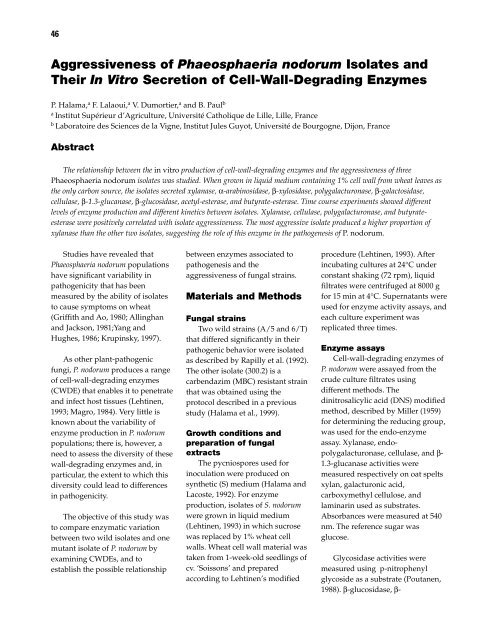Septoria and Stagonospora Diseases of Cereals - CIMMYT ...
Septoria and Stagonospora Diseases of Cereals - CIMMYT ...
Septoria and Stagonospora Diseases of Cereals - CIMMYT ...
You also want an ePaper? Increase the reach of your titles
YUMPU automatically turns print PDFs into web optimized ePapers that Google loves.
46<br />
Aggressiveness <strong>of</strong> Phaeosphaeria nodorum Isolates <strong>and</strong><br />
Their In Vitro Secretion <strong>of</strong> Cell-Wall-Degrading Enzymes<br />
P. Halama, a F. Lalaoui, a V. Dumortier, a <strong>and</strong> B. Paul b<br />
a Institut Supérieur d’Agriculture, Université Catholique de Lille, Lille, France<br />
b Laboratoire des Sciences de la Vigne, Institut Jules Guyot, Université de Bourgogne, Dijon, France<br />
Abstract<br />
The relationship between the in vitro production <strong>of</strong> cell-wall-degrading enzymes <strong>and</strong> the aggressiveness <strong>of</strong> three<br />
Phaeosphaeria nodorum isolates was studied. When grown in liquid medium containing 1% cell wall from wheat leaves as<br />
the only carbon source, the isolates secreted xylanase, α-arabinosidase, β-xylosidase, polygalacturonase, β-galactosidase,<br />
cellulase, β-1.3-glucanase, β-glucosidase, acetyl-esterase, <strong>and</strong> butyrate-esterase. Time course experiments showed different<br />
levels <strong>of</strong> enzyme production <strong>and</strong> different kinetics between isolates. Xylanase, cellulase, polygalacturonase, <strong>and</strong> butyrateesterase<br />
were positively correlated with isolate aggressiveness. The most aggressive isolate produced a higher proportion <strong>of</strong><br />
xylanase than the other two isolates, suggesting the role <strong>of</strong> this enzyme in the pathogenesis <strong>of</strong> P. nodorum.<br />
Studies have revealed that<br />
Phaeosphaeria nodorum populations<br />
have significant variability in<br />
pathogenicity that has been<br />
measured by the ability <strong>of</strong> isolates<br />
to cause symptoms on wheat<br />
(Griffith <strong>and</strong> Ao, 1980; Allinghan<br />
<strong>and</strong> Jackson, 1981;Yang <strong>and</strong><br />
Hughes, 1986; Krupinsky, 1997).<br />
As other plant-pathogenic<br />
fungi, P. nodorum produces a range<br />
<strong>of</strong> cell-wall-degrading enzymes<br />
(CWDE) that enables it to penetrate<br />
<strong>and</strong> infect host tissues (Lehtinen,<br />
1993; Magro, 1984). Very little is<br />
known about the variability <strong>of</strong><br />
enzyme production in P. nodorum<br />
populations; there is, however, a<br />
need to assess the diversity <strong>of</strong> these<br />
wall-degrading enzymes <strong>and</strong>, in<br />
particular, the extent to which this<br />
diversity could lead to differences<br />
in pathogenicity.<br />
The objective <strong>of</strong> this study was<br />
to compare enzymatic variation<br />
between two wild isolates <strong>and</strong> one<br />
mutant isolate <strong>of</strong> P. nodorum by<br />
examining CWDEs, <strong>and</strong> to<br />
establish the possible relationship<br />
between enzymes associated to<br />
pathogenesis <strong>and</strong> the<br />
aggressiveness <strong>of</strong> fungal strains.<br />
Materials <strong>and</strong> Methods<br />
Fungal strains<br />
Two wild strains (A/5 <strong>and</strong> 6/T)<br />
that differed significantly in their<br />
pathogenic behavior were isolated<br />
as described by Rapilly et al. (1992).<br />
The other isolate (300.2) is a<br />
carbendazim (MBC) resistant strain<br />
that was obtained using the<br />
protocol described in a previous<br />
study (Halama et al., 1999).<br />
Growth conditions <strong>and</strong><br />
preparation <strong>of</strong> fungal<br />
extracts<br />
The pycniospores used for<br />
inoculation were produced on<br />
synthetic (S) medium (Halama <strong>and</strong><br />
Lacoste, 1992). For enzyme<br />
production, isolates <strong>of</strong> S. nodorum<br />
were grown in liquid medium<br />
(Lehtinen, 1993) in which sucrose<br />
was replaced by 1% wheat cell<br />
walls. Wheat cell wall material was<br />
taken from 1-week-old seedlings <strong>of</strong><br />
cv. ‘Soissons’ <strong>and</strong> prepared<br />
according to Lehtinen’s modified<br />
procedure (Lehtinen, 1993). After<br />
incubating cultures at 24°C under<br />
constant shaking (72 rpm), liquid<br />
filtrates were centrifuged at 8000 g<br />
for 15 min at 4°C. Supernatants were<br />
used for enzyme activity assays, <strong>and</strong><br />
each culture experiment was<br />
replicated three times.<br />
Enzyme assays<br />
Cell-wall-degrading enzymes <strong>of</strong><br />
P. nodorum were assayed from the<br />
crude culture filtrates using<br />
different methods. The<br />
dinitrosalicylic acid (DNS) modified<br />
method, described by Miller (1959)<br />
for determining the reducing group,<br />
was used for the endo-enzyme<br />
assay. Xylanase, endopolygalacturonase,<br />
cellulase, <strong>and</strong> β-<br />
1.3-glucanase activities were<br />
measured respectively on oat spelts<br />
xylan, galacturonic acid,<br />
carboxymethyl cellulose, <strong>and</strong><br />
laminarin used as substrates.<br />
Absorbances were measured at 540<br />
nm. The reference sugar was<br />
glucose.<br />
Glycosidase activities were<br />
measured using p-nitrophenyl<br />
glycoside as a substrate (Poutanen,<br />
1988). β-glucosidase, β-









